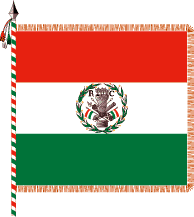 image by Mario Fabretto, 9 January 1997
image by Mario Fabretto, 9 January 1997
Last modified: 2021-01-01 by rob raeside
Keywords: italy | historical | cispadane republic | cisalpine republic | transpadane republic | legion lombarda | lombardy |
Links: FOTW homepage |
search |
disclaimer and copyright |
write us |
mirrors
Legion Lombarda circa 1796
 image by Mario Fabretto, 9 January 1997
image by Mario Fabretto, 9 January 1997
Cispadane Republic Flag
 image by Mario Fabretto, 9 January 1997
image by Mario Fabretto, 9 January 1997
See also:
Other Sites:
Yesterday we celebrated in Italy the bicentennial of our
tricolour flag. Actually, the date of 7 January 1797 corresponds
to the adoption of the Cispadane Republic
flag which was horizontally arranged with the emblem of the
Republic in the middle. The flag, in the form we use it today,
was adopted only on 17 July 1797 by the Cisalpine
Republic, which arose from the fusion of the Cispadana and Transpadana
Republics. The first vertical tricoloured design was, on the
contrary, adopted earlier, in 1796, for the regimental standards
of the Legione Lombarda, a military corps created in the
Transpadana Republic.
Mario Fabretto, 9 January 1997
From <he.net/~sirio/tricolore>:
From the acts of the XIV session of the Cispadane Congress
"Reggio Emilia, 7th January 1797, 11 hours. Patriotic Room.
The intervenients are 100, deputies of the populations of
Bologna, Ferrara, Modena and Reggio Emilia. Giuseppe Compagnoni
from Lugo puts a motion for the universal adoption of the
three-coloured green white and red Cispadane standard or flag,
and that these three colours are used also in the Cispadane
"Cocarda" (cockade worn on hats, lapels, etc.), which
should be used by all. It has been decreed so."
Dov Gutterman (Translated by Jorge Candeias), 11
January 1999
The site you refer to is owned by the Committee for the First
Tricolore. They are settled at Reggio Emilia, place where the
Italian Tricolore was first proposed, and they manage to maintain
alive the tradition and history of our national flag.
Pier Paolo Lugli, 11 January 1999
While I was in Madrid recently I visited an excellent art
gallery called the Museo Thyssen-Bornemisza. Among the paintings
that I saw there was one called 'Vista de Venezia, 1845' (view of
Venice, 1845') by an English artist named Robert Salmon.
Clearly visible on shipping in the foreground was the red-white-
red triflag of Austria; a blue flag with a red canton, presumably
that of Sardinia; and a plain green-white-red vertical tricolour.
The presence of the latter flag surprised me as I had thought it
only reappeared three years later - in 1848. I was inclined to
suspect that the painting might have been incorrectly dated when
I noticed that the date of the artist's death was also given as
1845. It would be comparatively easy to misdate a painting by a
few years, but I think it very unlikely that the date of an
artist's death would be incorrect too.
So, can anyone say whether the Italian tricolour was in common
use prior to 1848?
I am aware of the flag's origin in the revolutionary period, but
I thought that it then disappeared from view for a few decades
until its use was revived in 1848. The painting that I saw in
Madrid seems to indicate that it was openly flown in an Austrian
possession in 1845 and I find this rather surprising.
Vincent Morley, 19 October 1999
It is impossible that a Sardinian ship displayed a national
Italian tricolour before 1848
Pier Paolo Lugli, 22 October 1999
Maybe the painting was later restored and
"corrected" to the Italian flag either out of
vex-ignorance or out of misguided patriotism?
Antonio Martins, 22 October 1999
I think that is one of the two most likely explanations. The
other obvious explanation is that the flag was in popular but
unofficial use during the 1840s as a symbol of Italian unity and
independence - analogous to the use of the Green Flag in Ireland
at the same time.
On balance, I tend to favour the latter explanation for two
reasons:
1. Because the flag in the painting is a plain tricolour without
the defacing arms that might be expected if it were a post-1848
addition.
2. Because the tricolour was adopted as a
revolutionary symbol in 1848 - which suggests that it had not
been entirely forgotten during the preceding period.
However, the alternative explanation that António puts forward
certainly can't be dismissed.
Vincent Morley, 22 October 1999
The Italian colours that goes back further than the 1790s. The
colours may have been significant for many hundreds of years, as
they appear in Dante's Purgatorio (in Canto XXX, Beatrice appears
dressed in "white", "green" and "the
colour of living flame" (plus an olive crown); Dante calls
the colours "the signs of the old flame". Some
interpretations of the Comedy say that the colours symbolise
Faith, Hope, and Charity.
Kieron Merrett, 25 January 2006
An undoubtedly interesting and pleasing coincidence. But the
explanations and hypotheses on the page don't suggest a reference
to Dante's Divine Comedy. The green and white colours on the
uniforms of the Milan civic militia are derived more probably
from the flag of the Milan Dukedom
(Visconti flag, green snake on white field). We may ask the
question why Dante and the Viscontis choose those colours - it
might have been of the same reasons, but unless there's an
evidence that the chosen flag colours had been inspired by
Dante's work there can't be made a link between them.
Martin Karner, 25 January 2006
A. Ziggiotto "Le bandiere degli Stati italiani"
on "Armi Antiche" (1970) [zig70]
A. Ziggiotto "Le bandiere degli Stati italiani
pre-unitari" on Vexilla Italica 1, XXIV (1997) [zig97]
Mario Fabretto